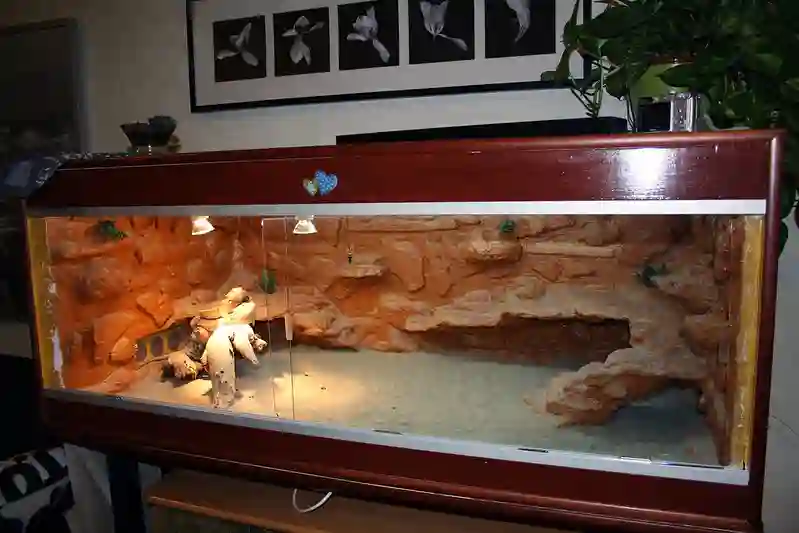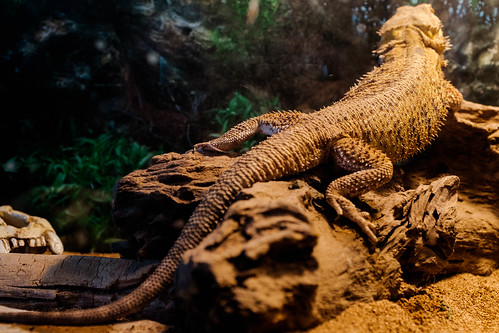The frequency of cleaning a bearded dragon tank depends on the size of the tank, the number of dragons living inside it, and the amount of waste they produce.
Here are some general guidelines:
- Every day, spot clean the tank.
- Every week (or at least every other week), do a more thorough cleaning.
- Every month or so, the vivarium will need a full clean, which includes removing all of the decoration and accessories, cleaning out the vivarium with a pet-safe disinfectant, and replacing the substrate.
- Every three months, do a deep clean of the terrarium, which involves changing the substrate and disinfecting the furniture for the tank, such as sticks or hammocks, and hides.
- For a 10-gallon tank, clean it at least once a week. For a 20-gallon tank, plan to clean it twice a week. If you have more than one bearded dragon in the tank, you’ll need to clean it more often.
Factors to Consider When Deciding How Often to Clean a Bearded Dragon Tank

Bearded dragons are fascinating creatures that require special attention when it comes to their care. One of the most important aspects of caring for them is maintaining a clean and healthy environment for them to live in. Several factors come into play when deciding how often to clean a bearded dragon tank.
Size of the tank relative to the size of the bearded dragon
The size of the tank is an essential factor when determining how often to clean it. The larger the tank, the less frequently you may need to clean it.
The size of your bearded dragon also comes into play when thinking about cleaning frequency. A bigger bearded dragon will produce more waste than a smaller one, so you may need to clean more frequently if your pet is on the larger side.
Number of bearded dragons in the tank
If you have multiple bearded dragons living in one tank, you’ll naturally need to clean more frequently than if there’s only one because there will be more waste produced with multiple pets.
Type and amount of substrate used in the tank
Substrate refers to whatever material is lining your pet’s enclosure floor. The type and amount can also affect how often you should change or clean out your pet’s enclosure completely.
For example, if you’re using a substrate like sand, which can harbor bacteria easily over time, it may require more frequent changes than other types like reptile carpet or paper towels.
Frequency and type of feeding
The frequency and type of feeding can also affect how often you’ll need to change out substrate or do spot cleaning on your pet’s enclosure. If you’re feeding fatty foods or items that take longer for your pet’s digestive system to break down, they may produce more waste, which means you’ll need to clean more frequently.
If your pet has a healthy diet with balanced nutrition, you may need to do less frequent cleaning. It’s best to consult with your vet about what is best for your pet’s unique dietary needs.
General Guidelines for Cleaning a Bearded Dragon Tank
Keeping a bearded dragon healthy and comfortable requires a clean environment. This section outlines the general guidelines for cleaning their tank.
Daily Tasks
- Spot cleaning: It’s essential to remove any solid waste from the tank daily to maintain hygiene. Use a reptile scoop or disposable gloves and dispose of the waste in a bin outside the house.
- Checking temperature and humidity levels: A stable temperature and humidity level are crucial for your bearded dragon’s health. Use a digital thermometer with probes to monitor the temperature of both ends of the tank, especially during feeding time.
- Refilling water dish: Always ensure that your pet has clean, fresh water available throughout the day, but never leave standing water in their tank as it can lead to bacterial growth.
Weekly Tasks
- Removing uneaten food: Remove any uneaten food from your pet’s dish within an hour after feeding them to prevent mold growth.
- Changing and washing any bedding or substrate: Depending on what type of substrate you use, it may need changing weekly or monthly or even longer periods between changes if it is paper towels or tile floors. If you use carpeting or sand as substrates in your pet’s enclosure, make sure to change it weekly because these materials can collect feces and bacteria over time.
- Wiping down all surfaces in the tank: Using lukewarm soapy water without any added chemicals will help keep tanks clean without endangering bearded dragons’ health by exposing them to harsh chemicals such as bleach spray cleaners that can be harmful if not rinsed thoroughly afterward.
Cleaning Tips for Specific Types of Substrate
Different types of substrate require different cleaning methods.
For sand, spot cleaning is important to remove feces and uneaten food. With reptile carpet or paper towels, the substrate can be removed and washed weekly.
It’s important to use mild detergents that do not contain any chemicals that could harm your pet.
For sand substrates, you should replace the sand completely every six months while maintaining it by removing any dead insects or feces.
Deep Clean a Bearded Dragon Tank
Deep cleaning a bearded dragon tank involves more than just wiping its surfaces with warm water. Hard water stains are a common issue with bearded dragon tanks, especially in areas with high mineral content in the tap water.
A solution of vinegar and water can safely remove these stains without using harmful chemicals like bleach or commercial cleaners that may harm your pet. Disinfecting surfaces involves using a reptile-safe disinfectant spray and allowing it to sit for a few minutes before rinsing it thoroughly.
Conclusion
Maintaining a clean environment in which your bearded dragon lives is crucial for keeping them healthy and happy. Cleaning frequency and methods vary depending on the type of substrate used in the tank, number of bearded dragons, and feeding frequency.
Taking the time to invest in good cleaning habits will benefit both your pet and you by ensuring a long-lasting relationship together. Remember to always research products before purchasing them for tank maintenance as not all cleaning agents are safe for reptiles.


Leave a Reply